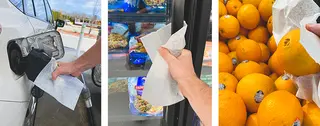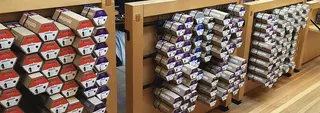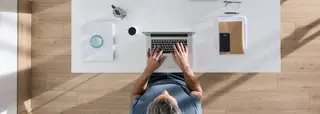
With protective gloves, disinfectant wipes and hand sanitizer scarce, Seaman Paper, a family-owned company headquartered in Gardner Massachusetts, is stepping in to help with their paper-based High-Touch Barrier Tissue, designed to help minimize direct hand contact with high-contact common surfaces, to the public.
“We have been a long-time supplier in the food service space,” says Julie Skibniewski, vice president of business development for Seaman Paper. “Because we serve certain segments that were using tissue paper as a sort of barrier it was logical, this product might work to meet this emerging need.”
That’s right, the tissue that is used to make sure no one touches your doughnut or bagel at places like Dunkin’ Donuts and Krispy Kreme can help protect you from picking up the virus from high traffic surfaces.
High-Touch Barrier Tissue is an FDA compliant paper (meaning it is suitable for direct contact with food) that provides much-needed protection at a time where protection can be hard to come by. While many applications for this product are non-food related, it can also be used as a barrier when shoppers must touch unwrapped produce in a grocery store. “This product serves a different need in a really important way,” says Skibniewski.
Paper is already being used by Indiana-based Family Express, in an expanded role. The small chain of convenience stores and fueling centers has installed dispensers of disposable tissue throughout the stores to keep people from passing germs by directly touching gas pumps, gas nozzles, PIN pads, touch screens, door handles, refrigerator handles, coffee machines, ATMS and/or any other surface in the store they deem high contact, according to The Northwest Indiana Times.
“We sought to create the most fortified open retail environment in the U.S. with these initiatives,” Gus Olympidis, president and CEO of Family Express, told The Northwest Indiana Times. “If a door handle is sanitized every 20 minutes, and it was sanitized 20 minutes ago, it doesn’t matter, if that person who walked in right in front of you has coronavirus.”
Available in two sizes (6”x10.75” and 8”x10.75”), High-Touch Barrier Tissue is boxed and can be displayed and dispensed almost anywhere there is high customer traffic. For now, Seaman Paper is supplying directly to their distributors, according to Skibniewski. “I think this is just one of those products that in the next two or three weeks, as word gets out, we might see new distribution channels emerge for it.”
High-Touch Barrier Tissue is also a much greener solution than gloves. The tissue can be recycled because it is paper-based. And, just as important, it would allow more access to the glove supply for frontline workers.
“In this time of heightened concern over the spread of viruses, we are happy to be able to bring an innovative solution that can help keep everyone healthy and safe,” says Seaman Paper owner Jamie Jones. “Our barrier tissue creates a paper-based alternative that has less of an environmental impact while also helping to ensure that our medical professionals and other emergency workers retain access to crucial glove supplies.”
High-Touch Barrier Tissue is also a lot gentler on hands than sanitizer and, at times, more protective than gloves.
“Gloves have a tighter surface and while they might be really protective, while when you are taking them off, if you are not taking them off properly, the virus is still on those gloves and has the potential to live for a longer period of time,” according to Skibniewski. “A recent study published this month in The Lancet, found that on printing and tissue paper, the virus could last for only 3 hours, much less time than on plastic.”




